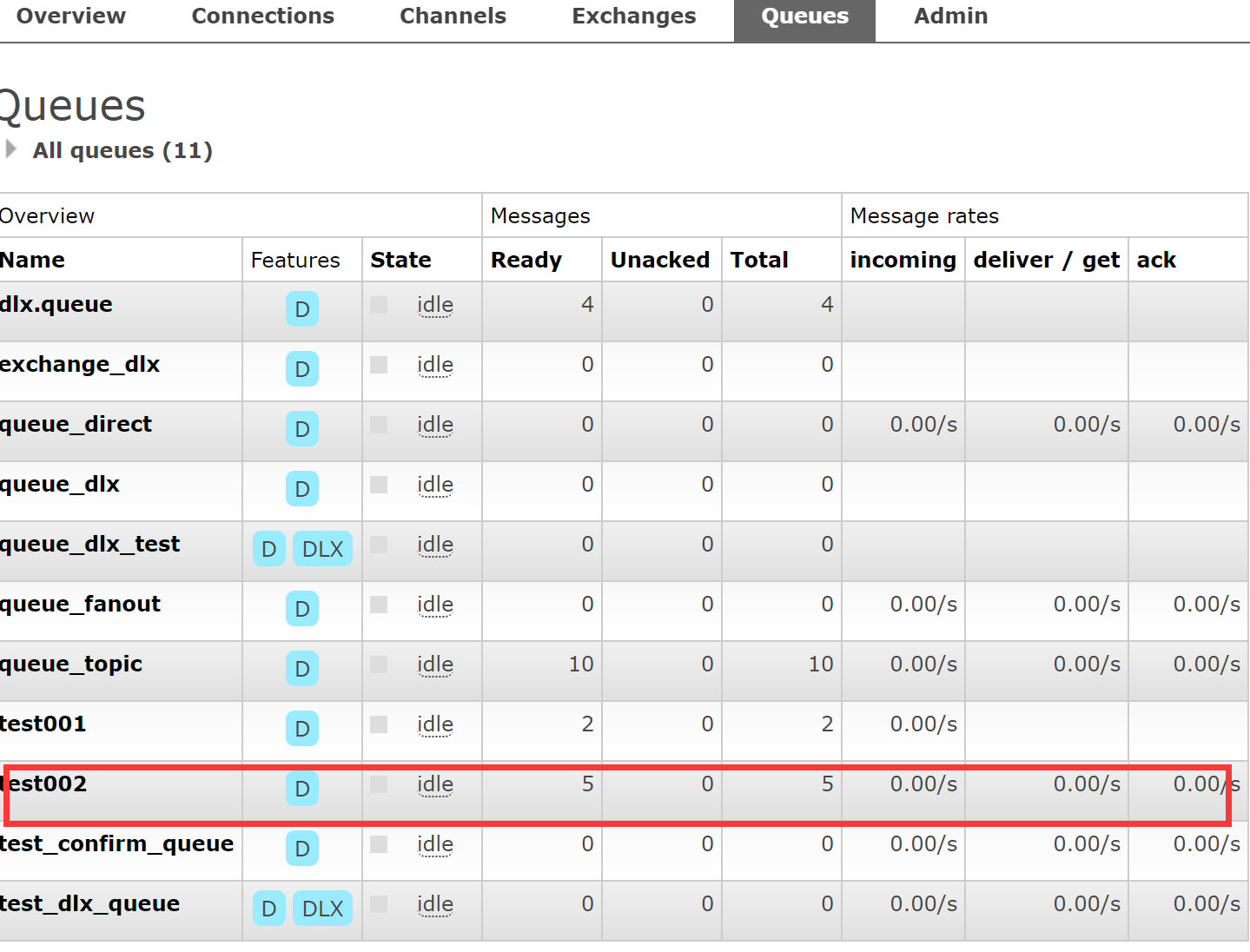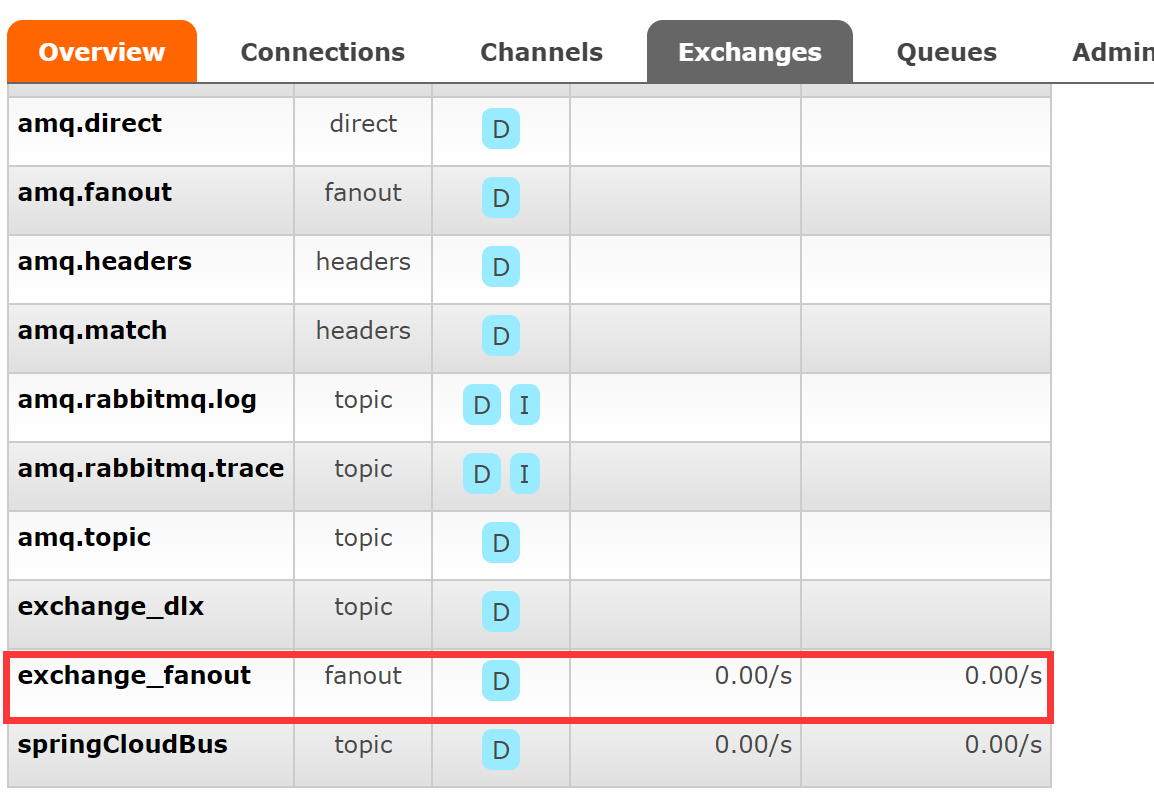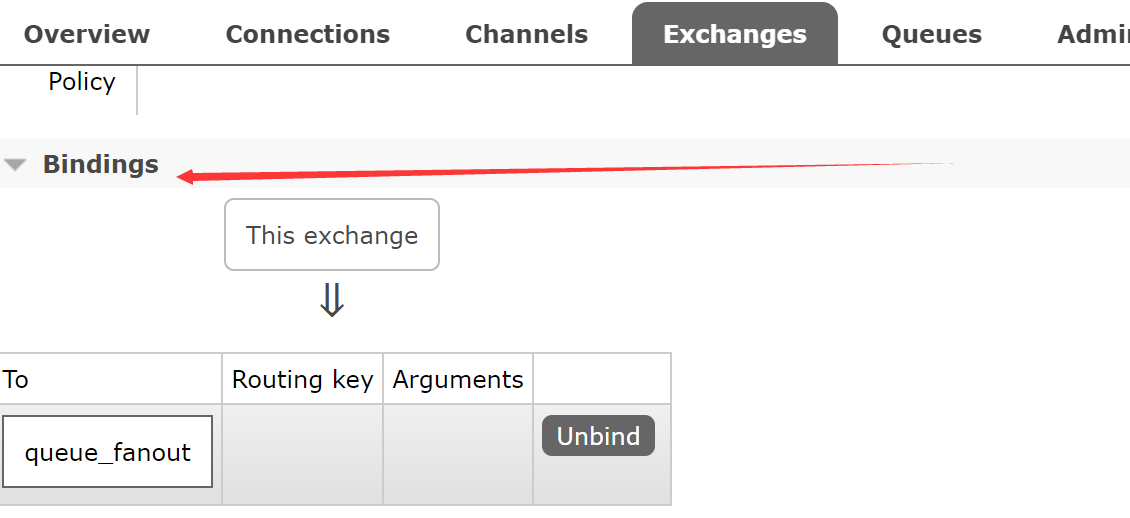RabbitMQ系列(三)--Java API
基于java使用RabbitMQ
框架:SpringBoot1.5.14.RELEASE
maven依赖:
<dependency>
<groupId>com.rabbitmq</groupId>
<artifactId>amqp-client</artifactId>
<version>3.6.5</version>
</dependency>
<dependency>
<groupId>org.springframework.boot</groupId>
<artifactId>spring-boot-starter-amqp</artifactId>
</dependency>
本文只是操作原生RabbitMQ,并没有和SpringBoot进行整合,后面介绍整合,基于注解使用
一、quick start
1.1、Consumer

public static void main(String[] args) throws Exception{ //1 创建一个ConnectionFactory, 并进行配置 ConnectionFactory factory = new ConnectionFactory(); factory.setVirtualHost("/"); factory.setHost("139.196.75.238"); factory.setPort(5672); //2 通过连接工厂创建连接 Connection connection = factory.newConnection(); //3 通过connection创建一个Channel Channel channel = connection.createChannel(); //4 声明(创建)一个队列 channel.queueDeclare("test002", true, false, false, null); //5 创建消费者 QueueingConsumer queueingConsumer = new QueueingConsumer(channel); //6 设置Channel channel.basicConsume("test002", true, queueingConsumer); while(true){ //7 获取消息 QueueingConsumer.Delivery delivery = queueingConsumer.nextDelivery(); String msg = new String(delivery.getBody()); log.info(msg); } } }
参数解释:
durable:是否持久化,Durable:是,即使服务器重启,这个队列也不会消失,Transient:否
exclusive:这个queue只能由一个exchange监听restricted to this connection,使用场景:顺序消费
autoDelete:当最后一个Binding到Exchange的Queue删除之后,自动删除该Exchange
arguments:参数
autoACK:是否自动签收,对应着手动签收
1.2、Producer

public class Producer { public static void main(String[] args) throws Exception{ //1 创建一个ConnectionFactory, 并进行配置 ConnectionFactory factory = new ConnectionFactory(); factory.setVirtualHost("/"); factory.setHost("139.196.75.238"); factory.setPort(5672); //2 通过连接工厂创建连接 Connection connection = factory.newConnection(); //3 通过connection创建一个Channel Channel channel = connection.createChannel(); //4 通过Channel发送数据 for(int i=0; i < 5; i++){ String msg = "Hello RabbitMQ!"; //1 exchange 2 routingKey channel.basicPublish("", "test002", null, msg.getBytes()); } //5 关闭相关的连接 channel.close(); factory.clone(); } }
参数解释:
exchange name:
routingKey:路由规则
BasicProperties:
body:message中的body
结果:
17:43:49.351 [main] INFO com.it.quickstart.Consumer - Hello RabbitMQ! 17:43:49.351 [main] INFO com.it.quickstart.Consumer - Hello RabbitMQ! 17:43:49.351 [main] INFO com.it.quickstart.Consumer - Hello RabbitMQ! 17:43:49.351 [main] INFO com.it.quickstart.Consumer - Hello RabbitMQ! 17:43:49.351 [main] INFO com.it.quickstart.Consumer - Hello RabbitMQ!
我们使用RabbitMQ,需要首先在可视化界面确定queue,exchange是否创建,对应关系是否正常,这是一个大前提

1.3、自定义消费者
之前接收message,通过while(true),感觉太low了,RabbitMQ支持实现自定义消费者,只需要集成DefaultConsumer,重写handlerDelivery,
构造器

public class MyConsumer extends DefaultConsumer { public MyConsumer(Channel channel) { super(channel); } @Override public void handleDelivery(String consumerTag, Envelope envelope, AMQP.BasicProperties properties, byte[] body) throws IOException { System.err.println("-----------consume message----------"); System.err.println("consumerTag: " + consumerTag); System.err.println("envelope: " + envelope); System.err.println("properties: " + properties); System.err.println("body: " + new String(body)); } }
而consumer只需要修改
//5 创建消费者 QueueingConsumer queueingConsumer = new QueueingConsumer(channel); //去掉这一步
//6 设置Channel channel.basicConsume("test002", true, new MyConsumer(channel));
结果:
-----------consume message---------- consumerTag: amq.ctag-YK7CnvWxTpm6hmuyUyqSkQ envelope: Envelope(deliveryTag=1, redeliver=false, exchange=, routingKey=test002) properties: #contentHeader<basic>(content-type=null, content-encoding=null, headers=null, delivery-mode=null, priority=null, correlation-id=null, reply-to=null, expiration=null, message-id=null, timestamp=null, type=null, user-id=null, app-id=null, cluster-id=null) body: Hello RabbitMQ By MyConsumer!
二、Exchange
Exchange有四种方式Fanout、Direct、Topic、Headers,而我们上面的例子,并没有定义Exchange,RabbitMQ默认使用AMQP default,
要求routing key和queue name相同

本文只是介绍前三种,Headers几乎用不到
2.1、Fanout
fanout效率是最好的,不需要routing key,你可以随便设置都无所谓,只要consumer和producer的Exchange name相同
producer

public class Producer { public static void main(String[] args) throws Exception{ ConnectionFactory factory = new ConnectionFactory(); factory.setVirtualHost("/"); factory.setHost("139.196.75.238"); factory.setPort(5672); Connection connection = factory.newConnection(); Channel channel = connection.createChannel(); String exchangeName = "exchange_fanout"; channel.basicPublish(exchangeName, "", null, "send message by fanout".getBytes()); } }
consumer

public class Consumer { public static void main(String[] args) throws Exception{ ConnectionFactory factory = new ConnectionFactory(); factory.setVirtualHost("/"); factory.setHost("139.196.75.238"); factory.setPort(5672); factory.setAutomaticRecoveryEnabled(true); factory.setNetworkRecoveryInterval(3000); Connection connection = factory.newConnection(); Channel channel = connection.createChannel(); String exchangeName = "exchange_fanout"; String exchangeType = "fanout"; String queueName = "queue_fanout"; String routingKey = ""; //不设置路由键 channel.exchangeDeclare(exchangeName, exchangeType, true, false, false, null); channel.queueDeclare(queueName, true, false, false, null); channel.queueBind(queueName, exchangeName, routingKey); channel.basicConsume(queueName, true, new MyConsumer(channel)); } }
结果:
-----------consume message---------- consumerTag: amq.ctag-rXw7SbaR5aWVMQxZY6SfEA envelope: Envelope(deliveryTag=1, redeliver=false, exchange=exchange_fanout, routingKey=) properties: #contentHeader<basic>(content-type=null, content-encoding=null, headers=null, delivery-mode=null, priority=null, correlation-id=null, reply-to=null, expiration=null, message-id=null, timestamp=null, type=null, user-id=null, app-id=null, cluster-id=null) body: send message by fanout
我们声明queue和exchange之后,要先观察exchange和queue对应关系

点击exchange name,进去查看是否binding成功,如果成功如下图

注意点:
1、fanout模式下不是直接操作Queue,而是把消息发送给Exchange,由Exchange把消息分发给与之绑定的Queue,也就是广播模式
2、Queue必须和Exchange进行绑定
3、每个Consumer的Queue name不能相同,个人测试下,相同的Queue name,只能有一个Consumer收到消息
2.2、Direct
完全把代码贴出来太浪费篇幅了,而且毫无意思,后面只说一下区别,顺便说一下,对于queue和exchange的declare无论放到producer还是
Consumer都可以的,个人习惯Consumer,而且二者启动顺序没有要求,因为RabbitMQ的消息具有堆积功能
Producer:
String exchangeName = "exchange_direct"; String routingKey = "key.direct"; channel.basicPublish(exchangeName, routingKey, null, "send message by direct".getBytes());
Consumer:
String exchangeName = "exchange_direct"; String exchangeType = "direct"; String queueName = "queue_direct"; String routingKey = "key.direct"; channel.exchangeDeclare(exchangeName, exchangeType, true, false, false, null); channel.queueDeclare(queueName, true, false, false, null); channel.queueBind(queueName, exchangeName, routingKey); channel.basicConsume(queueName, true, new MyConsumer(channel));
结果:
-----------consume message---------- consumerTag: amq.ctag-6UeNiGs1K-gMWbwvVn8F5A envelope: Envelope(deliveryTag=1, redeliver=false, exchange=exchange_direct, routingKey=key.direct) properties: #contentHeader<basic>(content-type=null, content-encoding=null, headers=null, delivery-mode=null, priority=null, correlation-id=null, reply-to=null, expiration=null, message-id=null, timestamp=null, type=null, user-id=null, app-id=null, cluster-id=null) body: send message by direct
说明:
Direct要求routingKey完全一致
2.3、 topic
Producer:
String exchangeName = "exchange_topic"; String routingKey1 = "user.save"; String routingKey2 = "user.update"; String routingKey3 = "user.delete.abc"; //5 发送 String msg = "Send Message By topic"; channel.basicPublish(exchangeName, routingKey1 , null , msg.getBytes()); channel.basicPublish(exchangeName, routingKey2 , null , msg.getBytes()); channel.basicPublish(exchangeName, routingKey3 , null , msg.getBytes());
Consumer:
String exchangeName = "exchange_topic"; String exchangeType = "topic"; String queueName = "queue_topic"; String routingKey = "user.*"; channel.exchangeDeclare(exchangeName, exchangeType, true, false, false, null); channel.queueDeclare(queueName, true, false, false, null); channel.queueBind(queueName, exchangeName, routingKey);
说明:
Topic支持通配符匹配,#匹配一个或多个单词,*匹配一个单词



